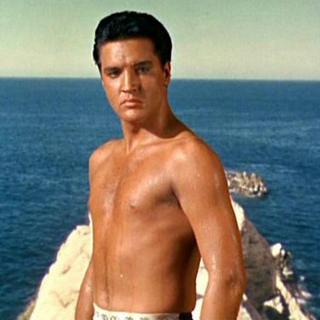Fun in Acapulco

"There's something about Elvis that a single ethnic or racial identity cannot contain. [. . .] You have a figure who breaks down if you fix him narrowly." (Greil Marcus)It's perhaps fitting that Elvis Presley made Fun in Acapulco without in fact visiting Mexico.
Though the film makes much of Acapulco's stunning coastal setting, and especially the cliffs from which Presley's character, Mike Windgren, dives to prove his manhood and get over the vertigo "problem" caused by his involvement in a circus accident that killed his brother, Elvis's presence in Mexico is only ever virtual, achieved through the use of back projection (previously discussed here), body doubles, and sets and stages recreated in a US studio.
Elvis functions like a spectre, a mediatized ghost overlaid over images of sun, sand, and coast, city streets, bars, hotels, and lounges. The magic of film and recorded sound can place this spectral Elvis anywhere, anytime. No wonder he continues to have hit records thirty years after his premature death, his image and voice transcending temporal or geographical distance.
A key component of popular culture, and the property that allows for its dispersal by means of the mass media, is its iterability. Fun in Acapulco was Presley's thirteenth film, but by no means his last, one in a series of what became increasingly formulaic repetitions of the same basic plot in which the singer played down-at-heel characters redeemed through music and irresistible to women.
Here, he is a fired deck-hand turned lifeguard who makes his name as a singer in hotels and clubs and who has to fend off the simultaneous advances of a young Mexican woman bullfighter (Elsa Cárdenas) and his hotel's Eastern European Assistant Social Director (Ursula Andress).
Most importantly, however, the film has to allow for the various set-piece musical numbers in which Elvis plays, well, Elvis, with his trademark vocal and physical gestures, all here adapted to a Latin beat. A certain reciprocity ensues: Elvis goes Latin (the film's big hit was the catchy "Bossa Nova Baby"), while Latin goes Elvis (the various hotel managers are made to bid for his performances, Cárdenas pursues him single-mindedly, and his macho Mexican rival has finally to admit defeat). Again and again: Elvis's music, and his spectral image, triumph over all adversities.
In some senses, then, the latinidad adopted by Fun in Acapulco is simply one more example of the minor variations within difference that constitute US (and more generally, Western) pop culture. Here, Elvis goes Latin; in King Creole he had gone jazz; in Blue Hawaii, Pacific Islander; and so on and so forth. Elvis proves himself to be a musical chameleon--without, for all that, ever ceasing to be instantly identifiable as Elvis.

Mediatized iterability, expansive reproduction through virtuality, and domesticated hybridity: these factors explain the now global spread of US mass culture. Any resistance is overcome first through charm, and second through the reiteration and (re-)representation of the potential sources of such resistance, but now on US terms.
So Elvis does Latin better than the house singer ("el trovador") that he rapidly eclipses, and Elvis (or rather, his double) even reproduces Acapulco's prime, exotic spectacle of the cliff dive: the tourists come to see the great Mexican diver enact this somewhat savage (because life-threatening) ritual, but find instead the all-American Elvis re-enacting it (complete with visit to cliff-top shrine) in his place.
Labels: mexico, repetition
